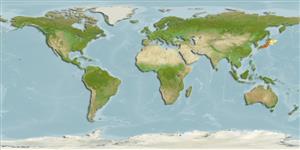>
Stomiiformes (Lightfishes and dragonfishes) >
Stomiidae (Barbeled dragonfishes) > Astronesthinae
Etymology: Borostomias: Greek, boros, -a, -on = gluttonous + Greek, stomías, -ou = a tough, hard -mouthed horse (Ref. 45335).
Environment: milieu / climate zone / depth range / distribution range
Écologie
marin bathypélagique; profondeur 350 - 1400 m (Ref. 58302). Temperate
Northwest Pacific: known only from Suruga Bay, Japan.
Taille / Poids / Âge
Maturity: Lm ? range ? - ? cm
Description synthétique
Clés d'identification | Morphologie | Morphométrie
Épines dorsales (Total) : 0; Rayons mous dorsaux (Total) : 12 - 14; Épines anales: 0; Rayons mous anaux: 17 - 19. Teeth on maxilla 10 to 13. POSTORB double. AC slightly arched. Barbel long, about 1.5 to 2.0 times as head length; stem sparsely pigmented, ending in a black swollen part with a prominent photophore on each side followed by a large ovate white bulb with a long filament arising at their junction.
Meso- and bathypelagic (Ref. 58302).
Life cycle and mating behavior
Maturities | Reproduction | Spawnings | Egg(s) | Fecundities | Larves
Masuda, H., K. Amaoka, C. Araga, T. Uyeno and T. Yoshino, 1984. The fishes of the Japanese Archipelago. Vol. 1. Tokai University Press, Tokyo, Japan. 437 p. (text). (Ref. 559)
Statut dans la liste rouge de l'IUCN (Ref. 130435)
Menace pour l'homme
Harmless
Utilisations par l'homme
Outils
Articles particuliers
Télécharger en XML
Sources Internet
Estimates based on models
Preferred temperature (Ref.
123201): 3.2 - 5.1, mean 3.3 °C (based on 5 cells).
Phylogenetic diversity index (Ref.
82804): PD
50 = 0.5156 [Uniqueness, from 0.5 = low to 2.0 = high].
Bayesian length-weight: a=0.00417 (0.00171 - 0.01014), b=3.05 (2.83 - 3.27), in cm total length, based on LWR estimates for this (Sub)family-body shape (Ref.
93245).
Niveau trophique (Ref.
69278): 3.7 ±0.6 se; based on size and trophs of closest relatives
Résilience (Ref.
120179): Milieu, temps minimum de doublement de population : 1,4 à 4,4 années (Preliminary K or Fecundity.).
Fishing Vulnerability (Ref.
59153): Low vulnerability (21 of 100).
